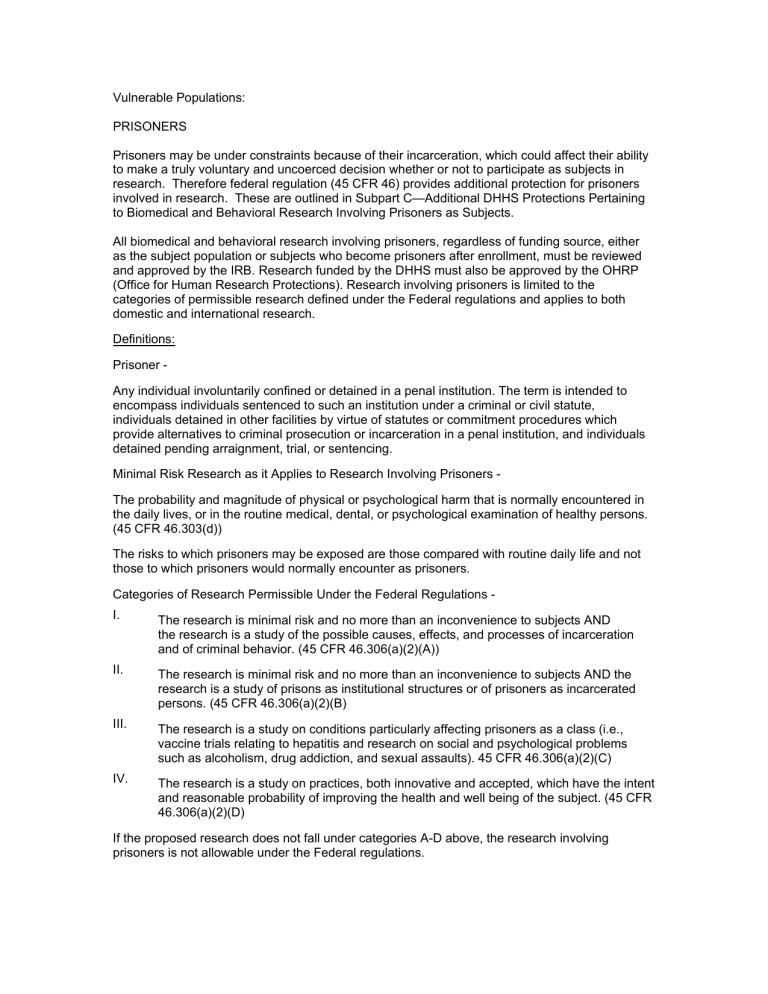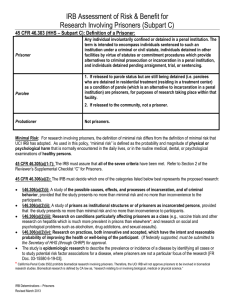Vulnerable Populations: PRISONERS

Vulnerable Populations:
PRISONERS
Prisoners may be under constraints because of their incarceration, which could affect their ability to make a truly voluntary and uncoerced decision whether or not to participate as subjects in research. Therefore federal regulation (45 CFR 46) provides additional protection for prisoners involved in research. These are outlined in Subpart C—Additional DHHS Protections Pertaining to Biomedical and Behavioral Research Involving Prisoners as Subjects.
All biomedical and behavioral research involving prisoners, regardless of funding source, either as the subject population or subjects who become prisoners after enrollment, must be reviewed and approved by the IRB. Research funded by the DHHS must also be approved by the OHRP
(Office for Human Research Protections). Research involving prisoners is limited to the categories of permissible research defined under the Federal regulations and applies to both domestic and international research.
Definitions:
Prisoner -
Any individual involuntarily confined or detained in a penal institution. The term is intended to encompass individuals sentenced to such an institution under a criminal or civil statute, individuals detained in other facilities by virtue of statutes or commitment procedures which provide alternatives to criminal prosecution or incarceration in a penal institution, and individuals detained pending arraignment, trial, or sentencing.
Minimal Risk Research as it Applies to Research Involving Prisoners -
The probability and magnitude of physical or psychological harm that is normally encountered in the daily lives, or in the routine medical, dental, or psychological examination of healthy persons.
(45 CFR 46.303(d))
The risks to which prisoners may be exposed are those compared with routine daily life and not those to which prisoners would normally encounter as prisoners.
Categories of Research Permissible Under the Federal Regulations -
I.
The research is minimal risk and no more than an inconvenience to subjects AND the research is a study of the possible causes, effects, and processes of incarceration and of criminal behavior. (45 CFR 46.306(a)(2)(A))
II.
The research is minimal risk and no more than an inconvenience to subjects AND the research is a study of prisons as institutional structures or of prisoners as incarcerated persons. (45 CFR 46.306(a)(2)(B)
III.
The research is a study on conditions particularly affecting prisoners as a class (i.e., vaccine trials relating to hepatitis and research on social and psychological problems such as alcoholism, drug addiction, and sexual assaults). 45 CFR 46.306(a)(2)(C)
IV.
The research is a study on practices, both innovative and accepted, which have the intent and reasonable probability of improving the health and well being of the subject. (45 CFR
46.306(a)(2)(D)
If the proposed research does not fall under categories A-D above, the research involving prisoners is not allowable under the Federal regulations.
Review Process
Research Involving Prisoners as the Subject Population:
If prisoners are proposed as part of the inclusion criteria in a new project application, at the time of initial review, the project will be reviewed with special consideration given to the 7 additional findings outlined under 45 CFR 46305(a). The investigator must complete the
‘Checklist for Studies Involving Prisoners’ and attach it with the new project application.
Research Involving Subjects Who Become Prisoners After Enrollment:
If the investigator becomes aware of a subject who becomes a prisoner after enrollment, the investigator should notify the IRB immediately by submitting a memorandum requesting an amendment to the project for inclusion of prisoners, along with a completed ‘Checklist for
Studies Involving Prisoners’. The IRB will re-review the protocol based on the 7 additional findings as outlined in the checklist.
Upon IRB approval of the research, the Research Compliance Office will send a certified letter to the OHRP, if applicable , for final approval. NOTE: The OHRP must approve all
DHHS research involving prisoners.







